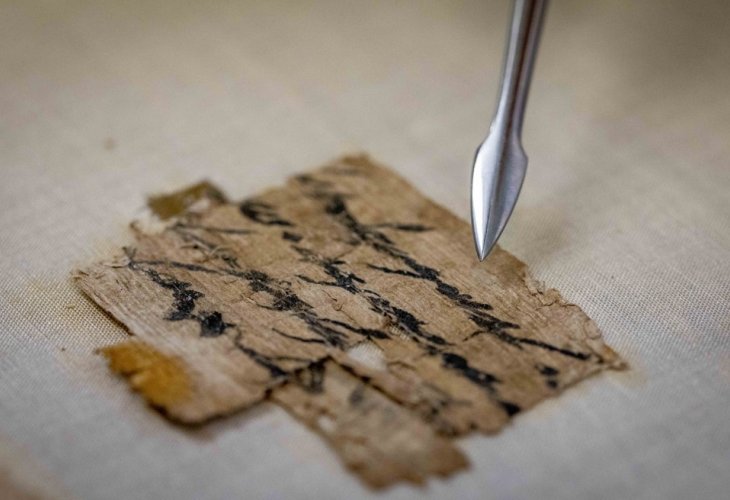An Ancient Scroll Returns: Rediscovering the First Temple Era
A rare First Temple-era document, mentioning the words 'to Ishmael you shall send...', has been returned to Israel following an intelligence operation.
 Papyrus Ishmael (Photo: Yonatan Sindel / Flash 90)
Papyrus Ishmael (Photo: Yonatan Sindel / Flash 90)A rare document from the First Temple era was recently returned to Israel, thanks to an intelligence operation and collaboration between the Antiquities Authority's Robbery Prevention Unit, Prof. Shmuel Ahituv, a winner of the Israel Prize for Bible Studies, the Ministry of Culture and Sport, and the Ministry of Jerusalem and Heritage.
This is an ancient and rare document written on papyrus in ancient Hebrew script from the First Temple period. So far, only two other papyri from that era exist in Israel. The document, believed to originate from one of the Judean Desert caves, contains four fragmented lines, beginning with the words 'to Ishmael you shall send[...].
The Antiquities Authority attempted to deduce the identity of this Ishmael. They suggest the document is likely a remnant of a letter containing instructions for the recipient. The dry climate of the Judean Desert enabled the preservation of this papyrus.
After the passing of Hebrew script scholar Dr. Ada Yardeni in June 2018, an unfinished manuscript of hers was handed to Prof. Ahituv, uncovering a photograph and preliminary decoding of an unknown rare First Temple-era document. A joint intelligence effort by the Antiquities Authority's Robbery Prevention Unit and Prof. Ahituv successfully located the document's holder and its location.
The document was in the hands of a Montana resident in the U.S. He revealed that the papyrus was given to his mother in 1965 during her visit to Israel by Yosef Sa'ad, curator of the Rockefeller Museum in Jerusalem, and Khalil Iskandar Kando, a well-known antiquities dealer from Bethlehem who previously sold thousands of Dead Sea Scroll fragments.
The document holder was invited to see the preservation lab of the Dead Sea Scrolls unit at the Antiquities Authority in Jerusalem. During the visit, he became convinced that the Antiquities Authority would provide the best preservation for the ancient document.
Prof. Shmuel Ahituv remarked, 'The name Ishmael, mentioned in the document, was common in the biblical era, meaning 'God will hear.' The name first appears in the Bible as the son of Abraham and Hagar and later as personal names of various biblical figures, including Ishmael ben Nethaniah, who assassinated Gedaliah ben Ahikam.
'The name also appears in the paleographic evidence of the First Temple period, notably as the names of officials in the Kingdom of Judah administration, on bullae (clay seal impressions) that authenticated state documents, such as the bulla 'to Ishmael son of the king'. It seems this document served as shipment confirmation from or to Ishmael,' he added.
Dr. Joe Uziel, head of the Dead Sea Scrolls unit at the Antiquities Authority, explained the distinction between ostraca (documents written on pottery) and seal rings, and papyri. 'We know of many findings indicating this, including collections of ostraca and seal impressions discovered in various urban centers, including Jerusalem, the kingdom's capital. However, documents made of organic materials — such as papyri — have scarcely survived,' he explained.
'To illustrate — from the Second Temple period we have thousands of scroll fragments. But from the First Temple era — only three documents, including the latest one. Each such document sheds additional light on the literacy and administration of the First Temple period,' concluded Dr. Uziel.
Feeling like you don't miss the Temple enough? The following video, demonstrating the grandeur and sanctity, will deeply connect you to the loss and yearning. Courtesy of the Megalim Institute:

